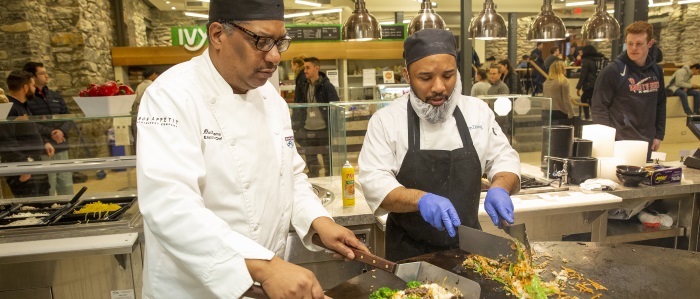Campus dining trends: Today's students, tomorrow's customers

What are high school and university students looking for in their dining programs?
- they love to customize
- more of them are choosing vegan food
- many enjoy the ease and flavors of the entire meal in one plate or bowl
Local sourcing also continues to resonate with young people, as does their interest in ethnic foods and flavors, and “simple” ingredients. So much of what was just beginning to trend a few years ago is now expected by Gen Zs and younger diners, your future customers.
Customization
“Students arrive at Penn wanting food prepared to their individual preferences,” says Pam Lampitt, who, as director of business services at University of Pennsylvania, Philadelphia, oversees campus dining as part of her responsibilities.
This trend toward ‘finished to-order’ has led to specialized stations in campus serveries. “Today, our dining halls feature Mongolian grills and power bowls stations, where customers choose their ingredients and our chefs finish the cooking.”
Vegan
“We’re seeing more and more students who have grown up eating vegan food, as opposed to choosing a vegan diet at a certain age,” Lampitt says. “These days, students have come to expect a choice of several vegan dishes, not just one token selection. We’ve also made a point to serve at least one vegetable on the line au natural – perfectly steamed, zero seasonings. Finding dairy alternatives that fit the diet and that students enjoy has been an ongoing challenge.”
One-dish dining
In the National Restaurant Association’s What’s Hot 2020 Culinary Forecast, healthy bowls ranked 4th out of 133 items rated as hot trends by more than 600 American Culinary Federation chefs. Power bowls are definitely popular with younger diners; many bowl meals also are perceived as healthy.
Updated “blue-plate specials” are popular, too. “Some of our students want something more special than the usual rotisserie chicken or brisket,” Lampitt says. “For them, we opened a cafe that serves a daily dinner entree. It’s a pre-set dish, beautifully plated, with all the food groups.”
Join dietitians and nutrition specialists from large and small restaurant chains at the National Restaurant Association Nutrition Conference, March 4-5, Fort Lauderdale, Fla.
Recent offerings include hangar steak with horseradish potatoes and greens; and jerk-spice-seasoned mahi-mahi over dirty rice pilaf, plantains and peas, finished with smoked avocado sauce. And yes, a vegan entree plate is featured in the weekly schedule.
Sourcing locally
Montana State University, an agricultural school in Bozeman, takes “locally sourced” seriously. MSU Culinary Services features food from local growers, processors and distributors — more than 100 vendors total — at all its food outlets as part of its Farm to Campus program. In 2018, this comprised about 25% of food purchases, including pork and beef that comes from the university’s agricultural curriculum.
A new program, rolled out in 2019, involves beekeeping. “The honey we collected last year is being used at our campus coffee shops as sweetener,” says Mike Kosevich, MSU associate director of culinary services.
Whole ingredients
“Since MSU has its own bakery and commissary, we’re able to offer fewer ingredients in our pre-packaged items, compared with commercially prepared items,” Kosevich says. “Labeling on our to-go foods reflect that as well — each ingredient is an actual food name. Students are looking for that.”
Nutrition info displays are becoming the norm, even at the high-school level. At Alexandria Public Schools, Alexandria, Minn., the goal is to be “nutrition educators,” says Food and Nutrition Services Director Janeen Peterson, RD, SNS. “We put nutritional info at students’ and parents’ fingertips with online apps and digital menu board displays.
And at MSU serveries, “iPads mounted at each station show all the ingredients,” Kosevich adds.
Ethnic, always
Ethnic continues to be a crowd-pleaser for all ages. “Even in this rural area of Minnesota, where meatloaf, mashed potatoes and hotdish [Minnesotan for casserole] top the charts, our students enjoy trying, and loving, the different flavors we’re offering in our ethnic entrees,” Peterson says.
To expand students’ culinary horizons, Alexandria schools have launched “Try It Tuesdays,” in which once a week, the dining halls “offer a fruit or vegetable that may be new to students or prepared in a way they may find more appealing,” Peterson adds.
At Penn, an increase in students of Muslim faith has led campus dining services to convert one dining hall to specialize in Halal food. “All the chicken we serve is certified Halal, and about half the beef. And none of the recipes use cooking wine,” Lampitt says.